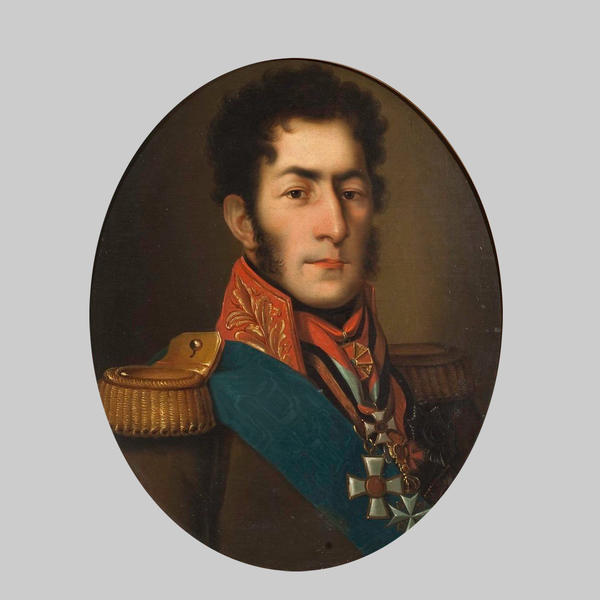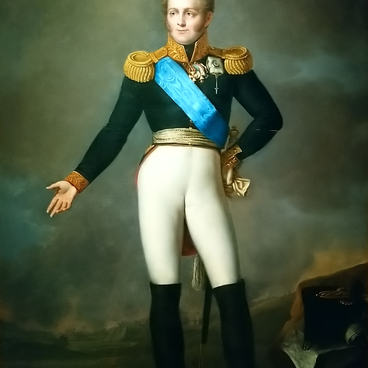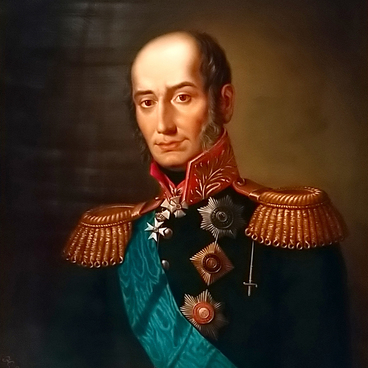Among heroes of the Patriotic War of 1812, a special place belongs to Prince Pyotr Bagration (1769-1812) of a venerable Georgian family. In 1809, Bagration, just 40 years old, who had joined the military as a sergeant in 1782, became a general of Infantry.
The rank, quite high in the military hierarchy in the Russian Army, was given to military personnel, assigned to command infantry troops. Those holding the rank, which was second by order of precedence, could pursue both political and state careers.
This achievement of Bagration was attributed to his participation in the Russo-Swedish War, as well as other successes dating back to Suvorov’s legendary campaigns to Italy and Switzerland. Suvorov, whom the would-be hero of the Battle of Borodino reported to since 1794, even mentioned the general in his letters to Emperor Paul, drawing the royal attention to “an outstanding general, worthy the highest ranks”.
The talent, acumen, and rare luck were duly noted by Bagration’s opponents as well. Among them Napoleon, against whom the Prince fought in 1805-1807, respected the military commander, considering him one of the finest in the Russian military.
The year 1811 saw Bagration commanding the Podolsk army, which would be renamed to the 2nd Western army in March 1812. His way to an eternal fame started in the suburbs of Grodno. It is there where the army met the war and was cut off from Barclay de Tolly’s main 1st Western army by Napoleon. Repelling the enemy’s attacks to his rear, Bagration pulled back to Bobruysk and Mogilev, fought a battle near Saltanovka and crossed the Dnepr. The maneuver proved to be instrumental in getting the army to Smolensk as soon as August 3 to join Barclay de Tolly’s troops, thus spoiling the plans of the French Emperor to destroy both armies on the border by splitting them to weaken and harass the opposing troops.
After the two armies came together, Bagration readily agreed to be subordinate to the other commander, despite the fact that he was superior in rank and that Emperor had not appointed anybody in overall charge. Though, a crack in Bagration’s respect to Barclay de Tolly appeared after the latter had let the French take over Smolensk. The Prince did not even try to conceal his criticism, openly voicing his disagreement with the commander’s strategy and tactics.
Comprising the left flank of the Imperial Army in the Battle of Borodino, Bagration’s troops repelled all attacks of the opponent, though at the price of heavy losses, prompting them to pull back behind the Semenovsky stream. In this legendary battle on September 7 (August 26) at about noon, Peter Bagration was severally wounded, when a fragment of a cannon ball hit him, crushing his left leg.
Having shed a lot of blood, the general was sent for treatment to Moscow, from where he moved to the estate of his friend, Prince Golitsyn. En route to his destination, a rough road and extreme humidity aggravated his condition, causing sepsis. Having refused to let his leg be amputated, the general died on September 24 (12) and was buried at a local church. Later the hero’s remains were moved to Borodino.
The rank, quite high in the military hierarchy in the Russian Army, was given to military personnel, assigned to command infantry troops. Those holding the rank, which was second by order of precedence, could pursue both political and state careers.
This achievement of Bagration was attributed to his participation in the Russo-Swedish War, as well as other successes dating back to Suvorov’s legendary campaigns to Italy and Switzerland. Suvorov, whom the would-be hero of the Battle of Borodino reported to since 1794, even mentioned the general in his letters to Emperor Paul, drawing the royal attention to “an outstanding general, worthy the highest ranks”.
The talent, acumen, and rare luck were duly noted by Bagration’s opponents as well. Among them Napoleon, against whom the Prince fought in 1805-1807, respected the military commander, considering him one of the finest in the Russian military.
The year 1811 saw Bagration commanding the Podolsk army, which would be renamed to the 2nd Western army in March 1812. His way to an eternal fame started in the suburbs of Grodno. It is there where the army met the war and was cut off from Barclay de Tolly’s main 1st Western army by Napoleon. Repelling the enemy’s attacks to his rear, Bagration pulled back to Bobruysk and Mogilev, fought a battle near Saltanovka and crossed the Dnepr. The maneuver proved to be instrumental in getting the army to Smolensk as soon as August 3 to join Barclay de Tolly’s troops, thus spoiling the plans of the French Emperor to destroy both armies on the border by splitting them to weaken and harass the opposing troops.
After the two armies came together, Bagration readily agreed to be subordinate to the other commander, despite the fact that he was superior in rank and that Emperor had not appointed anybody in overall charge. Though, a crack in Bagration’s respect to Barclay de Tolly appeared after the latter had let the French take over Smolensk. The Prince did not even try to conceal his criticism, openly voicing his disagreement with the commander’s strategy and tactics.
Comprising the left flank of the Imperial Army in the Battle of Borodino, Bagration’s troops repelled all attacks of the opponent, though at the price of heavy losses, prompting them to pull back behind the Semenovsky stream. In this legendary battle on September 7 (August 26) at about noon, Peter Bagration was severally wounded, when a fragment of a cannon ball hit him, crushing his left leg.
Having shed a lot of blood, the general was sent for treatment to Moscow, from where he moved to the estate of his friend, Prince Golitsyn. En route to his destination, a rough road and extreme humidity aggravated his condition, causing sepsis. Having refused to let his leg be amputated, the general died on September 24 (12) and was buried at a local church. Later the hero’s remains were moved to Borodino.



